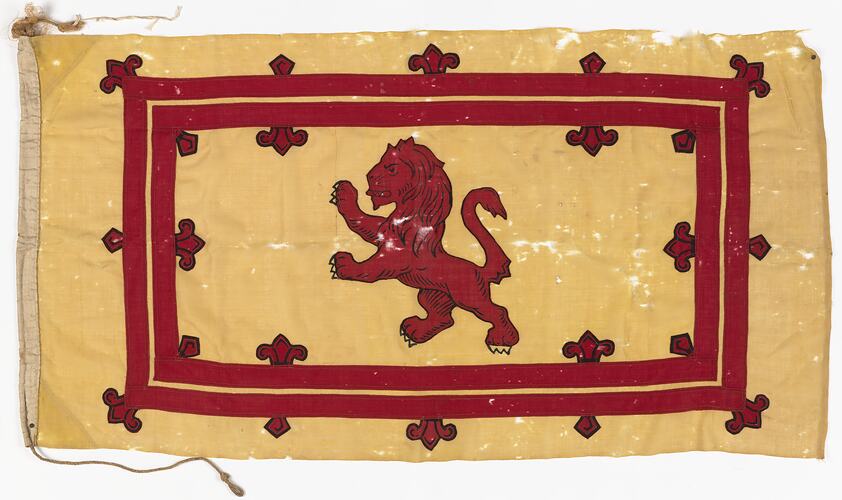Summary
Flag bearing the Scottish Standard "Lion Rampant". It was made for the formation of the Minyip branch of the Caledonian Society in 1906. Minyip in Victoria's western district, was notable for its high proportion of Scottish settlers, and in 1906 established its own Caledonian Society and Pipe Band. Its first chief was Mr Arch McDonald. The first of a number of Caledonian Sports was held in October 1906 and by 1908, the Society had completely kilted out the Pipe Band. Caledonian balls and concerts became a feature of the local social calendar. Many members enlisted during the First World War and consequently the activities gradually ceased. They were never revived.
The formation of cultural associations has long been a crucial way in which communities have maintained and fostered cultural traditions. The first documented appearance of Caledonian societies in Victoria occurred after the discovery of gold - the Comunn Na Feinne in Geelong (1856), the Highland Society of Maryborough (1857), the Caledonian Society of Victoria (1858, reconstituted in 1884 as the Caledonian Society of Melbourne), and the Caledonian Societies of Ballarat (1858) and Bendigo (1859).
These associations organised a variety of activities, including aid for ill or widowed Scots, social gatherings, sporting meets, and concerts. By the turn of the century there was an upsurge of activity by Scots and the societies, including the establishment of the Victorian Scottish Regiment (1898), the erection of Robert Burns statues in capital cities and the launch of a monthly journal 'The Scot at Hame an' Abroad' which continued for almost 30 years.
Physical Description
Flag: Scottish standard of the Caledonian Society, Minyip 1906 The standard shows a red lion, with a printed black outline against a yellow background. The lion is enclosed within a red rectangular border. Small red symbols with a printed black outline line the edges of the red border. The standard is designed to be viewed from one face only. The lion, border, symbols and field are all constructed from plain weave wool fabrics. These fabrics have been stitched together and machine stitched using red, black and yellow cotton yarns. The standard has a pole sleeve constructed from undyed plain weave wax and stitched with undyed cotton yarn. The pole sleeve encloses a jute rope with wooden toggle.
Significance
The standard provides a material symbol of the organised maintenance of Scottish cultural traditions and community, particularly in regional Victoria. It is a rare item, as few fragile textile objects such as this, often transient by nature, would survive the passing of time.
More Information
-
Collecting Areas
-
Acquisition Information
Donation from Mr & Mrs Kelvin & Marcia Penny, Nov 2002
-
Maker
Caledonian Society, Minyip, Mallee, Victoria, Australia, 1906
-
User
Caledonian Society, Minyip, Wimmera, Victoria, Australia, circa 1906-1920
-
Classification
-
Category
-
Discipline
-
Type of item
-
Object Measurements
173 cm (Length), 90 cm (Width), 2.3 cm (Height)
including toggle
-
References
Eric Richards, 'That Land of Exiles: Scots in Australia', Edinburgh, 1988
-
Keywords
Community Organisations, Flags, Immigration, Scottish Communities, Scottish Cultural Activities, Scottish Immigration, Scottish Textiles, Societies
